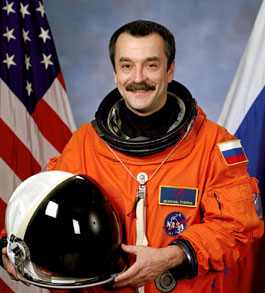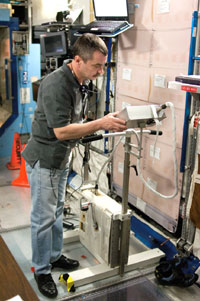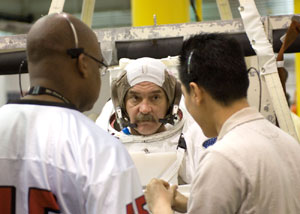Feature
Preflight Interview: Mikhail Tyurin
08.09.06
 There are hundreds of thousands of pilots and scientists out there in the world, but there are fewer than 50 Russian cosmonauts. I’m curious what it was that made you want to become a cosmonaut, to be one of those people who fly in space.
There are hundreds of thousands of pilots and scientists out there in the world, but there are fewer than 50 Russian cosmonauts. I’m curious what it was that made you want to become a cosmonaut, to be one of those people who fly in space.
Image to right: Cosmonaut Mikhail Tyurin, representing Russia's Federal Space Agency. Image credit: NASA
It’s hard to answer that question really, because I never thought of it as my main goal in life. I think it happened just by itself. I understand that it’s not really an answer to your question, but I didn’t set this task for myself because I think, this is not a major thing that you need to achieve in your lifetime. I don’t think of it as something that, if I accomplished it, my life would be over.
Tell me then, what, as you were a young boy growing up, what was it that you were interested in? What did you think you wanted to become when you became a man?
I wanted to be a hockey player.
How then did you become interested in engineering and in cosmonautics?
My parents made me do it.
Tell me about your education and your career, the things that have contributed to you becoming a cosmonaut.
Well, let’s just say that after I graduated from the university, I worked right away. I started working in a leading company that was involved in manned piloting and manned flights. I accumulated the experience and started working and became a cosmonaut.
The “flying in space” part of the job of a cosmonaut we know can be very dangerous. I’m interested to know what you feel we learn from flying people in space that makes it worth the risk that you’re willing to take for yourself.
I think that it is absolutely worth it, because even life shows, once in a lifetime, there is a law of self-regulating of things, and absurd things don’t really tend to survive in life; they kind of die by themselves. So, whether we understand or not, this survived. So, it’s necessary, I think.
You are the Flight Engineer on Expedition 14 to the International Space Station. Give me a summary of the goals of your Expedition, and what will be your main responsibilities.
Well, the primary goal of the Expedition crew is to keep on assembling the station and support and maintain the systems onboard. The primary objective of the on-board Engineer is to make sure the systems work.
Is it possible to say what is the most challenging aspect of the mission? Because in your case, you have an awful lot of traffic, many spaceships coming and going.
Right now, it’s hard to distinguish one separate task of the mission, which I would consider the hardest. I think life will prove me wrong.
Of course, you have flown to the International Space Station and done an increment there. How has that experience helped you get ready to fly this mission?
I think it definitely helped me prepare for this flight because it’s one thing to learn something on the ground, and it’s different to have to find something to work with in real life. It’s the same thing as reading a book and obtaining your own experience, so of course it helps.
Is there anything in particular that you learned in your 125 days on Expedition 3 that you think will help you be more efficient in your time on orbit this time?
I hope so. Among those, I would say that the previous flight taught me to be patient.
Is there anything that you think you’re most looking forward to seeing when you return to the International Space Station?
Well, what can I say? I think I’d like to see that everything’s in order onboard. I’d like to see my colleagues, there in good spirits and in good health. I will be ready to continue our work.
 You are going to begin this flight in a Soyuz spacecraft, which will be the first time in your career as a cosmonaut that you will be flying and, in fact, you will be commanding the Soyuz. Tell me about the Soyuz portion of this mission.
You are going to begin this flight in a Soyuz spacecraft, which will be the first time in your career as a cosmonaut that you will be flying and, in fact, you will be commanding the Soyuz. Tell me about the Soyuz portion of this mission.
Image to left: Expedition 14 Flight Engineer Mikhail Tyurin participates in a training session in the International Space Station Destiny laboratory mockup/trainer at Johnson Space Center's Space Vehicle Mockup Facility. Image credit: NASA
Well, actually, there’s nothing really to tell. Soyuz is a vehicle, which is intended to deliver the crew on board the station, along with necessary supply items. The flight consists of a series of dynamic operations, which is the maneuvering and docking, and then all of the dynamic operations that are related to deorbit and landing, which is very interesting.
On this time, when you arrive, you and Michael Lopez-Alegria will find one of your Expedition crewmates, Thomas Reiter, already there onboard the International Space Station. Do you believe that it will ease your transition to have one member of your crew already there and accustomed to what’s happening?
I hope it will help us, because, I assume that we will not have enough time to do the handover between crews. Therefore, it would be great and useful to have a person among our crew members who has already adapted to the life on orbit.
Expedition 3 did not have that advantage; did it take some time for you and your Expedition 3 crewmates to really feel comfortable?
Of course, it took some time.
Has the fact that you’re working with different crew make-ups had an impact on your training, on your preparations for the mission?
Yes, definitely—it made it harder. Because, in different combinations of different crew members, we use, sort of differently organized, layout of our responsibilities. So, in one composition, we work on different tasks and in the other, we perform different tasks, depending on the combination of the crew.
A portion of the training for your flight has also included working with the various shuttle crews who will be on the missions that will deliver new components to the station’s Integrated Truss Structure. Tell me a bit about the hardware pieces, about the P5 Truss and the S3/S4 Truss, and how those additions to ISS will improve its capability.
Well, it will be additional equipment, which will allow for different additional capabilities. It will improve the power balance and it will be, of course, more complex, to control the station at the same time.
What role will the Expedition crew play during the robotics operations and the extravehicular activities that will take place to add the S5 and the P5 and the S3/S4 to the station?
Well, first of all, Suni is going to actually participate in the actual EVA, herself, being a member of our crew. And, she will be trained and ready to perform the tasks, so we will have direct involvement. As far as my role? We’ll see what it will involve. The approach actually is a little different for the work onboard the station this time. We have long-duration flights, and we don’t think it makes sense to plan every minute of a long-duration flight because in life, everything will be a little different than what we expect to see, at the time of planning. But for training, of course, I participated in training to be able to participate in those activities as much as possible. So we may be involved in different tasks, pertaining to these goals.
On the various missions, when these new components are added and then subsequently the solar array wings on the P6 are going to be withdrawn, they’re going to be retracted back into the boxes, and we’ve never seen that before. Can you explain why that’s necessary, and how it’s accomplished?
Well, it is necessary in order to perform necessary activities for the assembly of the station. Because if we look at the external view of the station, you can see that there are a lot of protruding structural components such as solar arrays, radiators, and such. During assembly, some of these protruding appendages may be in the way of each other. Therefore, sometimes we have to deploy them or feather them into specific position. For example, during a shuttle approach and docking, we have to feather them, in order not to provide for a collision situation. How it is achieved? We have a drive and we just push a button. That’s very simple.
After the P5 portion of the truss is installed, the plan at this point is that there will be long periods when the station’s regular high data rate communications system is not going to be able to operate. I’m interested why that is happening at that point, and if you know how long it will last, and what impact will that have? What things will you not be able to do without that means of communication?
Well, there is, what we call, a Ku-band, comm[unication] loop, which we use, and it’s used with its own antenna. It will be retracted at this time or parked; therefore, it will not be operating. How will it impact the operation of the crew? I think it’s difficult to predict at this time. I don’t think it will have a huge impact. But, I tried to ask that question to the MCC-H [Mission Control Center-Houston] and MCC-M [Mission Control Center-Moscow] specialists, and as I found out, the specialists in both MCCs have not even started to evaluate that. So, I would like them to review that impact, and then we can discuss it.
 You and your crewmates are also training for spacewalks that you will conduct outside of the presence of the space shuttle missions. Can you tell me about the current plans for the Expedition crew to do spacewalks on Expedition 14?
You and your crewmates are also training for spacewalks that you will conduct outside of the presence of the space shuttle missions. Can you tell me about the current plans for the Expedition crew to do spacewalks on Expedition 14?
Image to right: Expedition 14 Flight Engineer Mikhail Tyurin gets help with final touches on the training version of his Extravehicular Mobility Unit spacesuit prior to being submerged in the waters of the Neutral Buoyancy Laboratory near Johnson Space Center, Houston. Image credit: NASA
Well, the primary goal is the same, which is to continue assembly, maintenance, installation of external, hardware items, removal of external hardware, and such. All of those things are really done in accordance to achieving the main goal. I don’t want to go into detail and list all of those tasks and all of the items and special components that will be worked on, using which bolts and so on. Those are all technical details, but the intention is, what I already said. And, we’re also going to plan one EVA for the Russian segment. Other than that, people usually do the same thing during each EVA. Something needs to be removed, something needs to be installed. Everything is very easy.
Along with spacewalks and maintaining the space station, another big reason for the space station to be there is for scientific research to be conducted. Can you tell me briefly about the Russian scientific agenda that you will be taking part in during your time in space?
Sure. It would be my pleasure. The Russian science program is pretty broad and contains experiments that lie within a huge spectrum of science experiments. A large portion of it is biomedical experiments, for some reason, they are always very popular, and, it’s true for both the U.S. segment and the Russian segment. I think they’re [what] everybody’s very interested in, learning more about the human science. Other equipment, other experiments include astrophysics, physics, plasma, magnetic experiments and microgravity experiments. There’s also a sociological portion of scientific experiments, which is a very interesting portion for us. Traditionally, we haven’t done a lot of work in this area. So, we hope to achieve some more.
I’m not familiar with the sociological experiment aspect either. What things are they looking into?
Well, there is a task, for example, that is basically learning of interaction between people. So, really a psychology of how people interact amongst themselves in a sociologically isolated environment, which is really the International Space Station. Also, there are some areas of research that would be used to photograph some areas of technogenic, catastrophes and where people basically begin to damage nature, such as make fire, create smoke, throw bombs on each other.
With Expedition 14, this will be the first time since before the loss of Columbia that there will be an International Space Station crew of three people from start to finish, and you’re going to have multiple shuttle visits, and multiple Progress visits that you’re looking at, and major station assembly going on. With that in mind, do you think at this point that the International Space Station Program is now ready to move on to full completion and full utilization?
I think that in fact, the question is not correctly posed. I think the condition of the station, and the condition of the, program never was interrupted in fact. It was just some different circumstances that made us change the process of assembly a little bit to tweak it, so to speak. So I think, we are still in a good shape, just as we were before.
And so you’re optimistic that we’re now poised to move on to completion and to bring the partners’ modules up and to use the station for the purpose it was intended?
Oh, of course. Without a doubt. Absolutely.
The purpose of the International Space Station—it has many uses in space—but its purpose is not our goal. Can you tell me how you see the International Space Station contributing to the future of mankind’s exploration of space?
That’s a very interesting question, which assumes that I will even think of something unexpected. But, I think that question was also posed to Mike [Lopez-Alegria], the Commander, during a press conference. And, I actually wanted to add to what he said, but it’s good that you gave me the opportunity to give you my answer. Besides everything that has been voiced many times over, what has been debated and discussed that this is an international, technical laboratory, I think it’s also a very interesting and big social and cultural laboratory. I think we have a unique program, and in about 20 or 30 years—I don’t know how many years it will take—but the station will become rusty and it will reach the end of its life. So the technical part of it will be over, but I think the experience that we’ve gained socially and culturally will remain, and it will teach people how to work together, how to apply, different cultural features and teach each other only good, not just bad stuff. So I think it will be useful in this area as well. And I think we need to accumulate this experience and not lose it.